Book contents
Introduction
Summary
The alliance between ecclesiastical and secular authority is almost as old as Christianity itself. What started as a purely spiritual commitment to a vision of Jesus Christ as the Son of God, had become by the fourth century inextricably entangled with the politics of the Empire. The support of Constantine and his successors converted bishops into imperial administrators, and the prayers of the faithful recognized and upheld the imperial authority. When the Empire in the West collapsed, the Church survived, and carried the concept of romanitas forward into a world of successor kingdoms, which often enough showed little political continuity, but were ambitious to preserve the ideal. The Pope was the Bishop of Rome, and based his claim to authority on that fact, an authority which was allowed to transcend that of the secular kingdoms and lordships because of what it symbolized. What these kingdoms sought above all else was authenticity, a validity which transcended the exploits of warlords and conferred upon their kings some echo of the imperial authority. It was this that the Church conferred. In creating dioceses and founding monasteries, rulers were entering into a compact with the Church, which in return for this material superstructure, recognized their power and interceded for them with God. The doctrine that this world is a mere antechamber to the next gave the Church an unchallenged cultural ascendancy which more than compensated for its lack of military muscle. Priests did not fight, they prayed, and prayer was as potent as the sword. As the Church expanded into hitherto pagan lands beyond the reach of the Empire, it was usually with the assistance of temporal lords who recognized the benefits which this alliance could confer upon themselves. It was by such means that the Roman Church embraced Anglo-Saxon England in the sixth and seventh centuries.
After the Norman conquest, relations between Rome and the Crown of England had fluctuated, but the one thing which no king could afford to do to the Church was to ignore it.
- Type
- Chapter
- Information
- The Religious Culture of Marian England , pp. 1 - 16Publisher: Pickering & ChattoFirst published in: 2014



